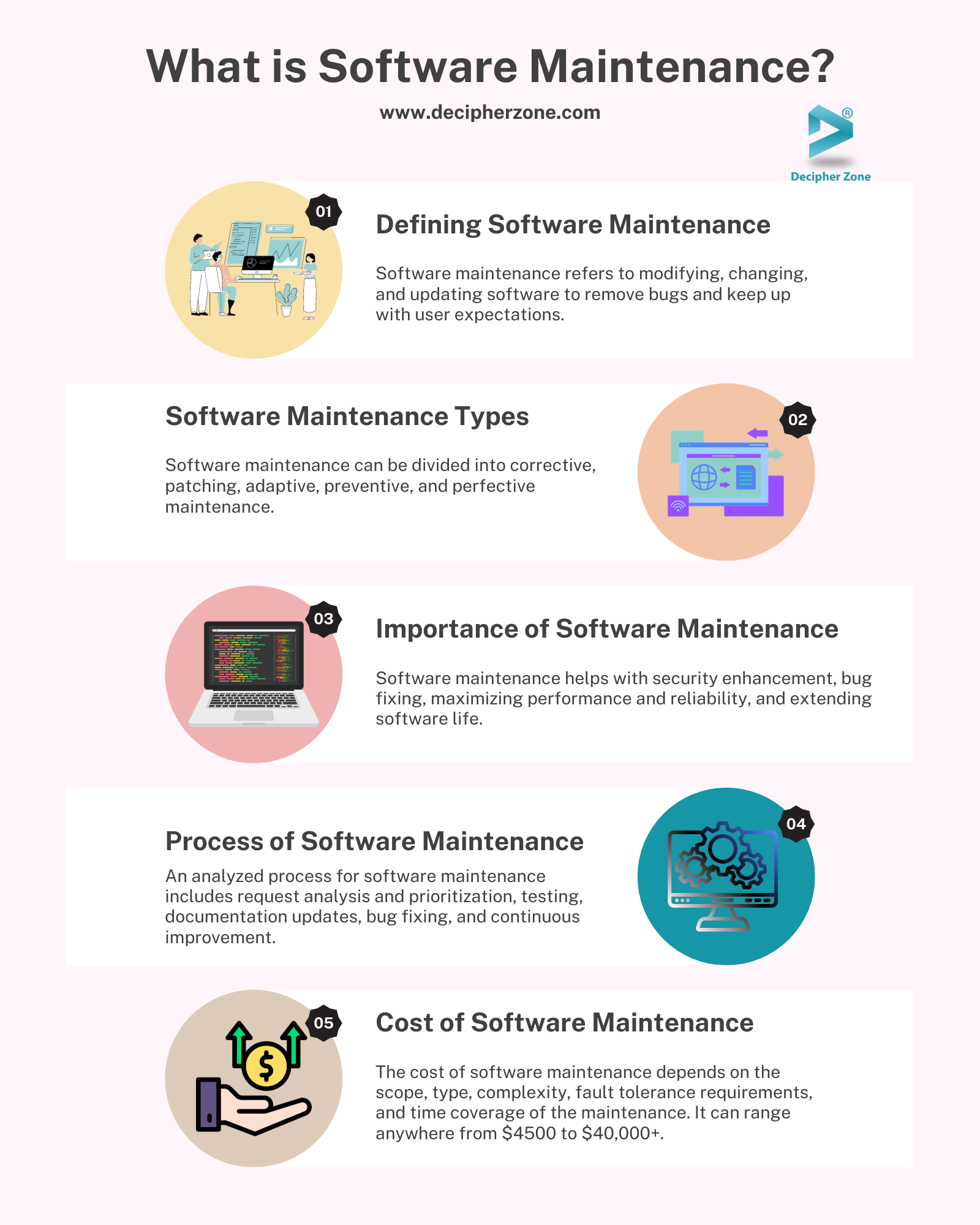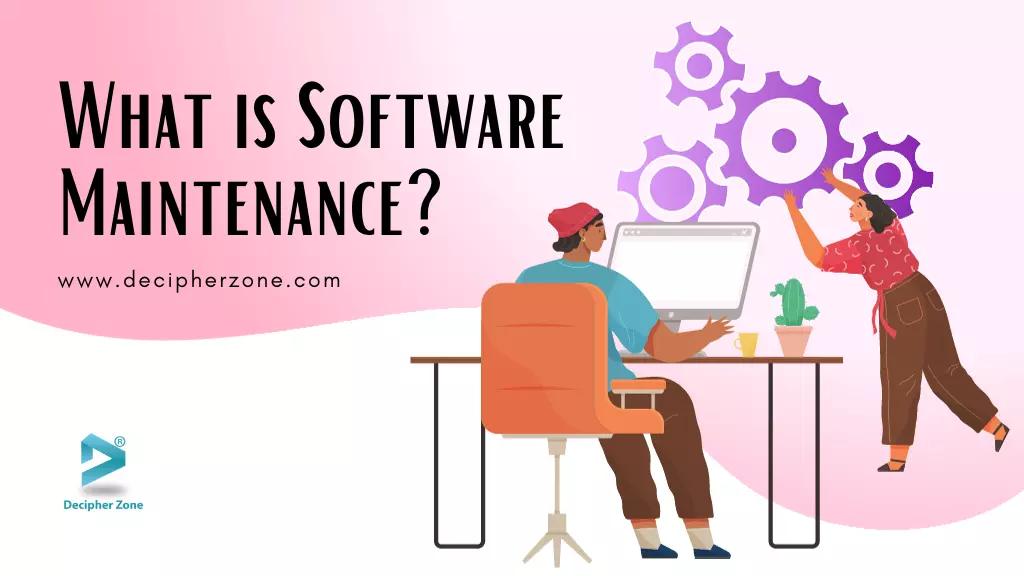What is Software Maintenance: Types, Process and Cost. The development and launch of software is only the starting point of its lifecycle. After the launch, the software goes through several stages of continuous development, improvement, and maintenance until it is no longer needed or replaced by a newer version.
This ongoing lifecycle involves monitoring, regular updates, bug fixes, security patches, and new feature additions to keep the software up-to-date, secure, and functional.
What is Software Maintenance: Types, Process and Cost
In this blog, we will explore the realm of software maintenance, how to achieve it, its importance, and more.
What is Software Maintenance
Software maintenance refers to modifying, changing, and updating software to remove bugs and keep up with user expectations. It can be done for multiple reasons, including but not limited to addressing errors, improving performance, adding features, enhancing capabilities, and ensuring stability.
Software maintenance is a continuous process that takes place throughout the software lifecycle. Therefore, one should also have a well-defined process for maintaining the software.
Some key aspects of software maintenance are testing and validation, version control, bug fixing, enhancement, porting and migration, re-engineering, and documentation.
Read More: Software Design Process and Tools
Types of Software Maintenance
Software maintenance can be categorized into:
-
Corrective Maintenance
-
Patching
-
Adaptive Maintenance
-
Perfective Maintenance
-
Preventive Maintenance
Corrective Maintenance
It involves addressing the software system’s errors, crashes, system failures, and bugs by identifying and fixing them.
Patching
It is a quick fix of the software code that resolves security and functionality issues. Patching is important as it helps update features, solve errors, and address known vulnerabilities.
Adaptive Maintenance
Adaptive maintenance aims to adjust the software system to match changes in the environment, such as hardware or software modifications, government policies, and business rules. This form of maintenance ensures that the software remains up-to-date and compatible with the most recent technologies and standards.
Perfective Maintenance
To enhance changeability, improve functionality, performance, and reliability, and restructure the software system, perfective maintenance is used. It aims to improve the software system to meet evolving user needs, increase efficiency, and make it easier to maintain and update.
Preventive Maintenance
Preventive maintenance aims to avoid future issues by optimizing the system, updating documentation, reviewing and testing it, and implementing preventative measures such as backups.
Preventive maintenance minimizes downtime and boosts overall system performance by identifying and addressing possible issues before they become significant problems.
Importance of Software Maintenance
Some of the major reasons why software maintenance is important are as follows:
-
Security Enhancement
-
Fix Bugs
-
Maximizing Performance and Reliability
-
Extending Software Lifecycle
Security Enhancement
As cyber threats are increasing, organizations need to prioritize the security of the software application. To improve application security, software maintenance plays a pivotal role as developers continuously implement security updates and patches.
Regular vulnerability assessments and audits help protect sensitive data, mitigate potential risks, and safeguard against malicious activity.
Fix Bugs
Optimizing software performance requires identifying and resolving issues that may affect its functionality. One of the most common issues is bugs, which can slow down the software and cause malfunctions.
To ensure seamless software performance, bug fixing should be a top priority in software maintenance. This process involves thoroughly examining the code to detect and correct errors that may occur in hardware, operating systems, or any part of the software.
It is crucial to fix these issues without compromising the existing functionalities of the software.
Read More: How to Choose a Software Development Company
Maximizing Performance and Reliability
Maintaining software is crucial to ensure that applications function consistently and reliably. As software is updated, patched, and improved, it is important to address any bugs and glitches.
Regular maintenance routines help to promptly identify and resolve these issues, preventing potential disruptions and ensuring a seamless user experience.
Read More: Operations Management Software Development
Extending Software Lifecycle
Developing software is a significant investment for any business. The aim behind software development is to maximize the returns on investment. That’s why keeping the software maintained will keep the software efficient and relevant while prolonging its lifecycle and minimizing frequent changes, saving both time and money.

Process of Software Maintenance
As we now know software maintenance is a critical part of the software development life cycle because it keeps the software secured and efficient in the long run. That’s why an analyzed process for software maintenance is required to preserve the functionality of the software.
It can look as follows:
-
Request Analysis and Prioritization
-
Testing
-
Documentation Update
-
Bug Fixes and Patching
-
Continuous Improvement
Request Analysis and Prioritization
In this stage, developers need to conduct performance monitoring, feedback gathering, and system log analysis to identify potential risks and prioritize maintenance based on their impact, severity, and alignment with business objectives.
Read More: Hire a Dedicated Backend Development Team
Testing
It is also important to integrate unit, integration, and regression testing to test the modified features and functionalities of the software for identifying abnormalities and resolving them.
Documentation Update
Ensure to update the technical documentation of the software to reflect all the changes made to its codebase, architecture, or configurations.
Bug Fixes and Patching
Immediately address any bugs, errors, or issues that have been identified after the deployment of the software and release patches as required to rectify the issues while improving the stability of the software.
Read More: 10 Types of Bugs in Software Testing
Continuous Improvement
Regularly engage with users and stakeholders to gather feedback to identify areas for improvement and optimize performance to enhance user satisfaction.
Cost of Software Maintenance
The cost of software maintenance can be up to two-thirds of the entire software development process approximately, i.e., it can range anywhere from $4500 to $40,000+.
The cost of software maintenance depends on both technical and non-technical factors, including module independence, programming style, programming language, validation and testing, documentation, configuration management techniques, software domain, software lifecycle, team stability, dependent on external environment, and hardware stability.
So, if you want to hire a software development team that can help you with both its development and maintenance, then contact our experts, share your requirements, and get a customized quote now!
FAQs: Software Maintenance
What is Software Maintenance?
Software maintenance refers to modifying, changing, and updating software to remove bugs and keep up with user expectations.
What are the types of software maintenance?
Software maintenance can be divided into corrective, patching, adaptive, preventive, and perfective maintenance.
What’s the cost of maintaining software?
The cost of software maintenance depends on the scope, type, complexity, fault tolerance requirements, and time coverage of the maintenance. It can range anywhere from $4500 to $40,000+.

